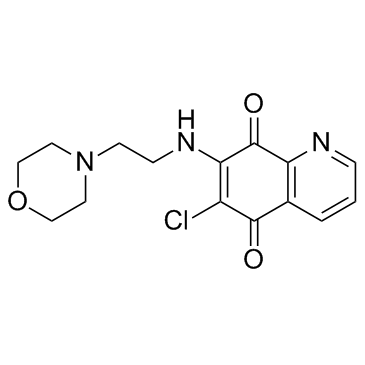NSC 663284(DA3003-1)
Modify Date: 2025-08-29 11:16:49

NSC 663284(DA3003-1) structure
|
Common Name | NSC 663284(DA3003-1) | ||
|---|---|---|---|---|
| CAS Number | 383907-43-5 | Molecular Weight | 321.759 | |
| Density | 1.4±0.1 g/cm3 | Boiling Point | 478.8±45.0 °C at 760 mmHg | |
| Molecular Formula | C15H16ClN3O3 | Melting Point | N/A | |
| MSDS | Chinese USA | Flash Point | 243.4±28.7 °C | |
| Symbol |

GHS07 |
Signal Word | Warning | |
Use of NSC 663284(DA3003-1)NSC 663284 is a Cdc25 dual specificity phosphatases inhibitor with an IC50 of 0.21 μM. |
| Name | 6-chloro-7-(2-morpholin-4-ylethylamino)quinoline-5,8-dione |
|---|---|
| Synonym | More Synonyms |
| Description | NSC 663284 is a Cdc25 dual specificity phosphatases inhibitor with an IC50 of 0.21 μM. |
|---|---|
| Related Catalog | |
| Target |
IC50: 0.21 μM (Cdc25 dual specificity phosphatase)[1] |
| In Vitro | The Cdc25 dual specificity phosphatases have central roles in coordinating cellular signaling processes and cell proliferation. NSC 663284 exhibits mixed competitive kinetics against Cdc25A, Cdc25B2, and Cdc25C with Ki values of 29, 95, and 89 nM, respectively. NSC 663284 blocks cellular Erk dephosphorylation caused by ectopic Cdc25A expression. NSC 663284 displays a strong preference for Cdc25B2 as compared with VHR or PTP1B, the relative IC50 values for Cdc25B2 are 20- and 450-fold lower than for VHR or PTP1B, respectively. NSC 663284 blocks cell proliferation and the actions of cellular cdc25a. NSC 663284 has a mean IC50 value in the NCI 60 Cell Human Tumor Panel of 1.5 (0.6 µM when cells are treated for 48 h). Most sensitive are human breast cancer MDA-MB-435 and MDA-N cells, which have IC50 values of 0.2 µM[1]. |
| In Vivo | NSC 663284 inhibits the growth of subcutaneous human colon HT29 xenografts in SCID mice. After a single i.v. dose of 5 mg/kg, NSC 663284 is not detectable in plasma or tissues beyond 5 min. Following NSC 663284 treatment of tumor-bearing SCID mice, reduces glutathione concentrations in HT29 tumor are decreased to a greater extent and remained decreased for longer than the reduced glutathione concentrations in liver and kidneys[2]. |
| Animal Admin | Mice: C.B.-17 SCID mice bearing HT29 human colon carcinoma xenografts are stratified into the following groups of 9-10 animals: Control, vehicle control, positive control (gemcitabine, 50 mg/kg/dose i.v.), NSC 663284 at the following doses: 2, 3 or 5 mg/kg/dose i.v.. The mice are dosed every 4 days for 6 doses, and body weights and tumor volumes are recorded twice weekly. Tumors are measured with calipers, and tumor volumes are calculated. Mice are followed for 3 weeks following the completion of the dosing to monitor tumor regrowth. In a second study, C.B.-17 SCID mice bearing MDA-MB-435 human breast cancer xenografts are stratified to the same treatment groups, except that paclitaxel at 20 mg/kg i.v. every 7 days is used as the positive control[2]. |
| References |
| Density | 1.4±0.1 g/cm3 |
|---|---|
| Boiling Point | 478.8±45.0 °C at 760 mmHg |
| Molecular Formula | C15H16ClN3O3 |
| Molecular Weight | 321.759 |
| Flash Point | 243.4±28.7 °C |
| Exact Mass | 321.088013 |
| PSA | 71.53000 |
| LogP | 0.33 |
| Vapour Pressure | 0.0±1.2 mmHg at 25°C |
| Index of Refraction | 1.626 |
| InChIKey | BMKPVDQDJQWBPD-UHFFFAOYSA-N |
| SMILES | O=C1C(Cl)=C(NCCN2CCOCC2)C(=O)c2ncccc21 |
| Storage condition | 2-8℃ |
| Symbol |

GHS07 |
|---|---|
| Signal Word | Warning |
| Hazard Statements | H315-H319-H335 |
| Precautionary Statements | P261-P305 + P351 + P338 |
| Personal Protective Equipment | dust mask type N95 (US);Eyeshields;Gloves |
| RIDADR | NONH for all modes of transport |
| 6-Chloro-7-(2-morpholin-4-yl-ethylamino)quinoline-5,8-dione |
| DA3003-1 |
| 6-chloro-7-{[2-(morpholin-4-yl)ethyl]amino}quinoline-5,8-dione |
| 5,8-Quinolinedione, 6-chloro-7-[[2-(4-morpholinyl)ethyl]amino]- |
| 6-Chloro-7-{[2-(4-morpholinyl)ethyl]amino}-5,8-quinolinedione |
| NSC 663284 |